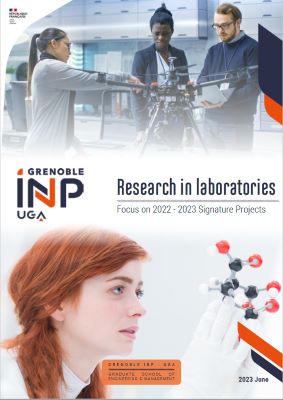
The lengthy challenge Catherine Picart has set herself is to find a way to repair serious forms of bone damage which cannot be healed by existing techniques. (1) The adventure began with proofs of concept funded by the European Research Council (ERC), which enabled her to lay the foundations of her project at LMGP** to develop new multi-purpose materials made from biopolymers. In 2016 she reached a crucial milestone by demonstrating how biomimetic film can help repair femur bones in rats. (2) ‘Composed of hyaluronic acid, among other elements, this film mimics a natural matrix,’ Catherine Picart explains. ‘It forms a kind of mesh that holds a specific growth factor, which stimulates bone-forming cells.’ This breakthrough, accomplished in partnership with Professor Bettega, head of the Maxillofacial Surgery Unit at Annecy hospital, led to a patent in 2020. These bioactive membranes proved effective in moderate lesions, but for more extensive defects, a new approach was required.
From film to a 3D implant
In the case of more severe damage, the simple film applied to a single surface was no longer sufficient and the surface had to be increased. The solution came in the form of 3D polymer implants, developed by 3D printing (additive manufacturing) and applied to the entire inner and outer surfaces of these biomimetic films. This is achieved through a simple soaking process used widely in industry. The 3D polymeric structure thus acts like a skeleton and enables the bone to regenerate in the pores of the bioactive 3D implant. The bone regeneration process is triggered by the bioactive film. In pre-clinical trials run by Marcy l’Etoile Veterinary School, the implants proved effective in repairing bone defects in the jaws of miniature pigs. The results of this trial were published in 2021. (3) More recently, in a joint study with Maisons Alfort Veterinary School and the Bordeaux Clinical Investigation Centre, a metatarsal bone (the equivalent of a tibia) was healed in sheep. The results, published in 2024 (4), confirm full recovery of the damaged bones.
A start-up in the pipeline
This innovation promises a vast array of applications. Dental or maxillofacial surgery, orthopaedics or spine repair; the bioactive 3D implants may offer an alternative to bone grafting, an often painful process ill-suited to patients suffering from pathologies such as diabetes or osteoporosis.
Catherine Picart and her team now have a clear aim: to industrialise these implants and make them available to the widest number of patients. This move towards serial production, supported by the SATT Linksium incubator and Grenoble INP and CNRS evaluation units, will begin with the creation of a start-up, APIOS, in 2025. 2026 should see the first clinical trials on humans, using ready-to-use implants adapted to personalised treatment.
The potential is huge, given the substantial needs. In the USA, bone grafts are among the most common medical interventions after blood transfusions. Thanks to invaluable support, in particular that of the Gueules Cassées foundation and the French Medical Research Foundation (FRM), Catherine Picart is set to transform a scientific approach into a concrete solution for patients worldwide.
* Biomimetics and Regenerative Medicine
**CNRS / UGA / Grenoble – INP, UGA
1) 10.1016/j.biomaterials.2018.07.017
2) 10.1016/j.biomaterials.2016.06.001
3) 10.1016/j.mtbio.2021.100113
4) 10.1002/adhm.202301692



